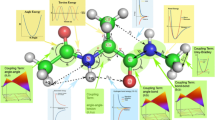Abstract
We present a new competitive method for the atomic scale treatment of macromolecular flexibility called Static Mode method. This method is based on the “induced-fit” concept, i.e. it maps the intrinsic deformations of a macromolecule subject to diverse external excitations. The algorithm makes it possible to obtain a set of deformations, each one corresponding to a specific interaction on a specific molecular site, in terms of force constants contained in the energy model. In this frame, the docking problem can be expressed in terms of interaction sites between the two molecules, the molecular deformations being extracted from the pre-calculated Static Modes of each molecule. Some preliminary basic examples aimed at illustrating potential applications where macro- or bio-molecular flexibility is of key importance are given: flexibility inducing conformational changes in the case of furanose ring and flexibility for the characterization, including allostery, of poly(N-isopropylacrylamide)(P-NIPAM) active sites. We also discuss how this procedure allows “induced-fit” flexible molecular docking, beyond state-of-the-art semi-rigid methods.
Similar content being viewed by others
References
H.J. Wolfson, M. Shatsky, D. Schneidman-Duhovny, O. Dror, A. Shulman-Peleg, B. Ma, R. Nussinov, Curr. Protein Pept. Sci. 6, 171 (2005).
A.M.J.J. Bonvin, Curr. Opin. Struct. Biol. 16, 194 (2006).
N. Brooijmans, I.D. Kuntz, Annu. Rev. Biophys. Biomol. Struct. 32, 335 (2003).
E. Fischer, Ber. Deutsch. Chem. Ges. 27, 2985 (1894).
D. Koshland, Proc. Natl. Acad. Sci. U.S.A. 44, 98 (1958).
D. Koshland, Science 142, 1533 (1963).
D. Koshland, Angew. Chem. Int. Ed. Engl. 33, 2375 (1994).
W. Jorgensen, Science 254, 954 (1991).
F. Tama, Y.-H. Sanejouand, Protein Eng. 14, 14, 1 (2001).
K. Hinsen, Proteins: Struct. Funct. Genet. 33, 417 (1998).
D.A. Case, T.A. Darden, I.T.E. Cheatham, C.L. Simmerling, J. Wang, R.E. Duke, R. Luo, K.M. Merz, B. Wang, D.A. Pearlman, M. Crowley, S. Brozell, V. Tsui, H. Gohlke, J. Mongan, V. Hornak, G. Cui, P. Beroza, C. Schafmeister, J.W. Caldwell, W.S. Ross, P.A. Kollman, AMBER8, University of California, San Francisco (2004).
M.J. Frisch, G.W. Trucks, H.B. Schlegel, G.E. Scuseria, M.A. Robb, J.R. Cheeseman, J.A. Montgomery, T. Vreven, K.N. Kudin, J.C. Burant, J.M. Millam, S.S. Iyengar, J. Tomasi, V. Barone, B. Mennucci, M. Cossi, G. Scalmani, N. Rega, G.A. Petersson, H. Nakatsuji, M. Hada, M. Ehara, K. Toyota, R. Fukuda, J. Hasegawa, M. Ishida, T. Nakajima, Y. Honda, O. Kitao, H. Nakai, M. Klene, X. Li, J.E. Knox, H.P. Hratchian, J.B. Cross, V. Bakken, C. Adamo, J. Jaramillo, R. Gomperts, R.E. Stratmann, O. Yazyev, A.J. Austin, R. Cammi, C. Pomelli, J.W. Ochterski, P.Y. Ayala, K. Morokuma, G.A. Voth, P. Salvador, J.J. Dannenberg, V.G. Zakrzewski, S. Dapprich, A.D. Daniels, M.C. Strain, O. Farkas, D.K. Malick, A.D. Rabuck, K. Raghavachari, J.B. Foresman, J.V. Ortiz, Q. Cui, A.G. Baboul, S. Clifford, J. Cioslowski, B.B. Stefanov, G. Liu, A. Liashenko, P. Piskorz, I. Komaromi, R.L. Martin, D.J. Fox, T. Keith, M.A. Al-Laham, C.Y. Peng, A. Nanayakkara, M. Challacombe, P.M.W. Gill, B. Johnson, W. Chen, M.W. Wong, C. Gonzalez, J.A. Pople, GAUSSIAN03 ReV C.01, Gaussian, Inc.: Pittsburgh (2003).
M. Levitt, A. Warshel, J. Am. Chem. Soc. 100, 2607 (1978).
V.N. Bartenev, N.G. Kamenevaand, A.A. Lipanov, Acta Crystallogr. B 43, 275 (1987).
K. Arora, T. Schlick, Chem. Phys. Lett. 378, 1 (2003).
G.A. Meints, T. Karlsson, G.P. Drobny, J. Am. Chem. Soc. 123, 10030 (2001).
C. Altona, M. Sundaralingam, J. Am. Chem. Soc. 94, 8205 (1972).
S. Rao, E. Westhof, M. Sundaralingam, Acta Crystallogr. A 37, 421 (1981).
W. Saenger, Principles of Nucleic Acid Structure (Springer-Verlag, 1984).
H.P.M. de Leeuw, C.A.G. Haasnoot, C. Altona, Isr. J. Chem. 20, 108 (1980).
M. Heskins, J.E. Guillet, J. Macromol. Sci. Chem. A 2, 1441 (1968).
H.G. Schild, Prog. Polym. Sci. 17, 163 (1992).
A.D. Becke, J. Chem. Phys. 98, 5648 (1993).
A. Estève, A. Bail, G. Landa, A. Dkhissi, M. Brut, M. Djafari Rouhani, J. Sudor, A.M. Gue, Chem. Phys. 340, 12 (2007).
Author information
Authors and Affiliations
Corresponding author
Rights and permissions
About this article
Cite this article
Brut, M., Estève, A., Landa, G. et al. The Static Modes: An alternative approach for the treatment of macro- and bio-molecular induced-fit flexibility. Eur. Phys. J. E 28, 17–25 (2009). https://doi.org/10.1140/epje/i2008-10397-0
Received:
Accepted:
Published:
Issue Date:
DOI: https://doi.org/10.1140/epje/i2008-10397-0




